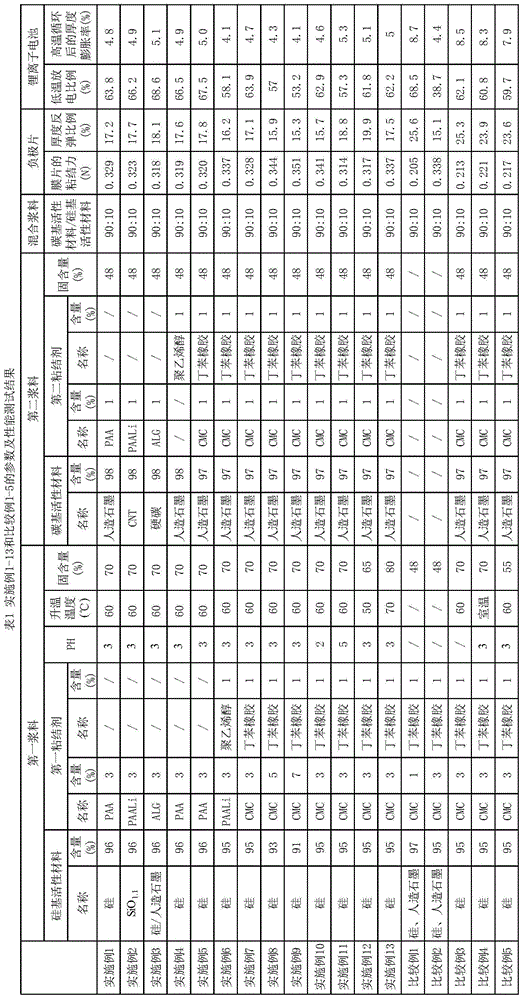Lithium ion battery, negative plate thereof and preparation method thereof
A technology for lithium-ion batteries and negative plates, applied in battery electrodes, non-aqueous electrolyte storage battery electrodes, circuits, etc., can solve the problems of deterioration of charge and discharge performance of carbon-based active materials, achieve good low-temperature discharge performance and high-temperature cycle performance, and good Electrochemical performance, the effect of improving the adhesion force
- Summary
- Abstract
- Description
- Claims
- Application Information
AI Technical Summary
Problems solved by technology
Method used
Image
Examples
preparation example Construction
[0019] According to the preparation method of the negative electrode sheet of the lithium ion battery of the second aspect of the present invention, it is used to prepare the negative electrode sheet of the lithium ion battery of the first aspect of the present invention, comprising the steps: (1) silicon-based active material, first conductive agent, The first binder is added to the solvent deionized water in proportion to stir and mix evenly, then the pH value is adjusted to be less than 7, and then the temperature is raised and the stirring is continued to make the solid content of the slurry reach the specified value, and the first slurry is obtained, wherein the silicon-based active material The surface of the surface contains -OH, and the first binder includes at least a binder containing -COOM, wherein M is selected from one of H, Li, Na, K, Mg, Al, Ca, Zn; (2) the The carbon-based active material, the second conductive agent, and the second binder are added in proportio...
Embodiment 1
[0036] 1. Preparation of Negative Electrode for Lithium-ion Batteries
[0037] (1) Add silicon particles with a silicon-based active material D50 of 3 μm, the first conductive agent SuperP, and polyacrylic acid with a molecular weight of 400,000 as the first binder in a mass ratio of 96:1:3 to the solvent deionized water, and stir well to mix evenly , then use oxalic acid to adjust the pH value of the slurry to 3, then slowly raise the temperature of the slurry to 60°C and continue to stir until the solid content of the slurry is 70%, to obtain the first slurry, wherein the surface of the silicon particles contains -OH ;
[0038] (2) Add artificial graphite with a carbon-based active material D50 of 15 μm, the second conductive agent SuperP, and polyacrylic acid with a molecular weight of the second binder of 400,000 in a mass ratio of 98:1:1 into the solvent deionized water, fully stir and mix evenly , forming a second slurry with a solid content of 48%;
[0039] (3) The se...
Embodiment 2
[0048] Lithium-ion batteries were prepared according to the method of Example 1, except for the following differences:
[0049] 1. Preparation of Negative Electrode for Lithium-ion Batteries
[0050] (1) The silicon-based active material is SiO1.1 with a D50 of 3 μm, the surface of SiO1.1 contains -OH, and the first binder is lithium polyacrylate with a molecular weight of 800,000;
[0051] (2) The carbon-based active material is carbon nanotubes, and the second binder is lithium polyacrylate with a molecular weight of 800,000.
PUM
| Property | Measurement | Unit |
|---|---|---|
| Thickness | aaaaa | aaaaa |
| Width | aaaaa | aaaaa |
| Length | aaaaa | aaaaa |
Abstract
Description
Claims
Application Information
 Login to View More
Login to View More - R&D
- Intellectual Property
- Life Sciences
- Materials
- Tech Scout
- Unparalleled Data Quality
- Higher Quality Content
- 60% Fewer Hallucinations
Browse by: Latest US Patents, China's latest patents, Technical Efficacy Thesaurus, Application Domain, Technology Topic, Popular Technical Reports.
© 2025 PatSnap. All rights reserved.Legal|Privacy policy|Modern Slavery Act Transparency Statement|Sitemap|About US| Contact US: help@patsnap.com

